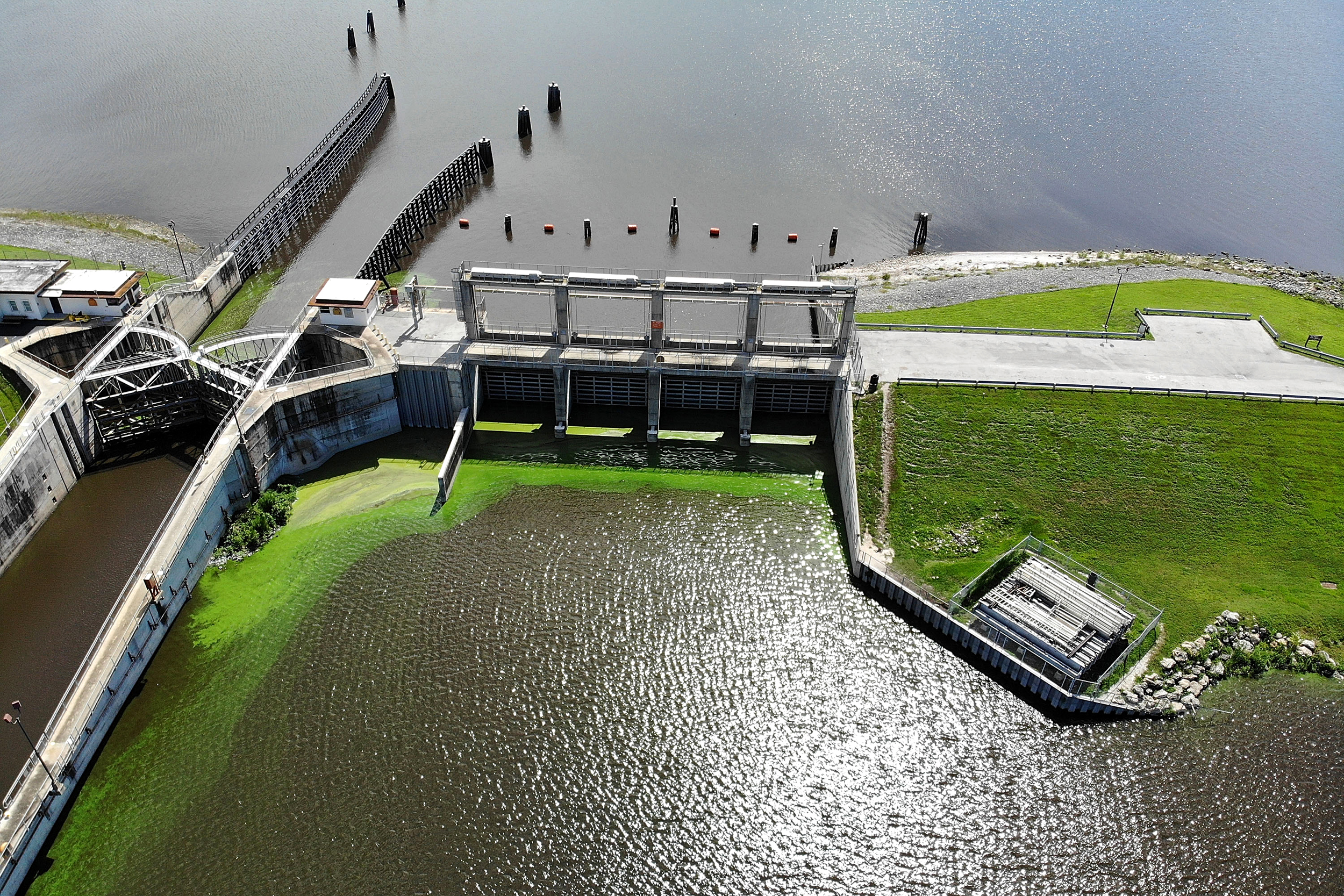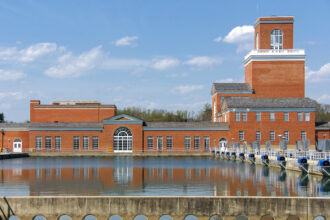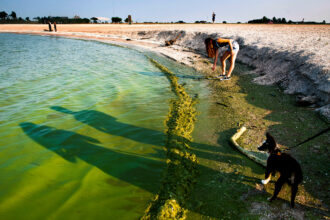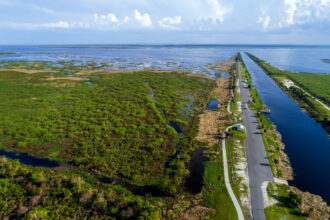At the heart of the vast watershed that forms Florida’s fragile Everglades is Lake Okeechobee. A century ago the water of the state’s largest lake spilled effortlessly beyond its southern shore, flowing eventually into the sawgrass prairies of the river of grass.
Today the natural course of the water has been altered forever by some of the most complex water management infrastructure in the world. This infrastructure has drained the river of grass to a fraction of its former size and made modern Florida possible. A $21 billion federal and state restoration effort underway in the Everglades is among the most ambitious of its kind in human history.
A new plan for managing Lake Okeechobee is aimed at recapturing some of this drained water and restoring a more natural flow throughout the watershed, two objectives that, if achieved, could help alleviate yet another prominent environmental problem facing the state: toxic algae.
The Lake Okeechobee System Operating Manual (LOSOM), implemented earlier this month, represents a significant shift in the lake’s management. Coming after a recent restoration of the 143-mile earthen dike encircling the lake, the plan is designed to more equitably balance the needs of the watershed and stakeholders tied to it, rather than prioritizing flood control above all else, said Tim Gysan, LOSOM project manager for the U.S. Army Corps of Engineers.
“At some point most Floridians are touched by water that moves through Lake Okeechobee,” he said. “The management of Lake Okeechobee is very important.”
The 730-square-mile lake is situated near the center of the watershed that encompasses much of the peninsula, beginning in central Florida at the headwaters of the meandering Kissimmee River. The watershed also includes the sawgrass marshes south of the lake and Florida Bay, at the peninsula’s southernmost tip. Today some 2,200 miles of canals, 2,100 miles of levees and berms, 84 pump stations and 778 water control structures sustain the river of grass, which is responsible for the drinking water of some 9 million Floridians.
Notably, the new lake plan likely will bring some relief from the toxic algae that has gripped the peninsula during the past several years by addressing one of the biggest problems hindering the natural course of water in the Everglades: releases from Lake Okeechobee in an unnatural pattern east and west rather than south, as the water once flowed.
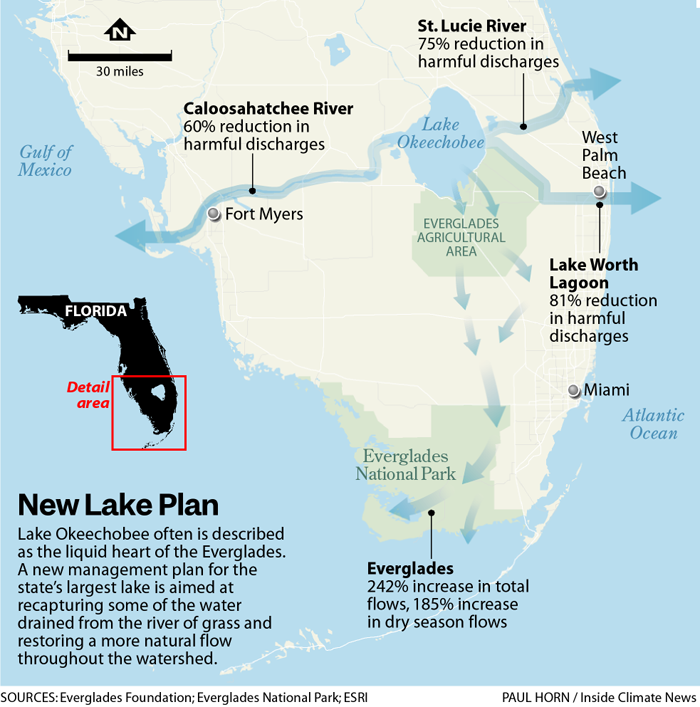
The noxious blooms have choked rivers, sullied beaches, sickened Floridians and left wildlife belly-up. The discharges were necessary during times of high water to protect the aging dike surrounding the lake, but the releases threaten the delicate estuaries on either side of the lake and, during the summer months, can spread toxic algae. Because the algae thrive in warm temperatures, the problem is poised to get worse as the global climate warms.
Now that a $1.8 billion rehabilitation of the dike is complete, the Army Corps will have more flexibility to hold more water in the lake, reducing the harmful discharges. It is the first time a lake plan has acknowledged the risk of toxic algae or recognized the need to send more water south for the Everglades, said Eve Samples, executive director of Friends of the Everglades, an advocacy group. Her group said the plan allows for releases when the lake level climbs above 16.5 to 17 feet.
“Acknowledgement does not always equate to action,” she said. “There are no guarantees we will be protected from harmful discharges.”
The Everglades Foundation, another advocacy group, estimated the releases east to the St. Lucie River will decrease by 75 percent, and discharges west to the Caloosahatchee River will decline by 60 percent. Flows south to the Everglades will increase by 242 percent.
A more robust Lake Okeechobee means better water supply for the vast sugar cane and vegetable fields south of the lake. But the higher water does represent a drawback for the lake itself. Decades of pollution have clouded the lake’s once-crystalline water, and when the water is too deep, less sunlight can reach the vegetation undulating beneath the surface. The vegetation supports the gamefish popular among anglers and serves as a natural water filter removing the pollution from the water, said Steve Davis, chief science officer at the Everglades Foundation.
“I really do think this plan marks a cultural shift on the part of the Army Corps of Engineers because they really put into writing some concerns and priorities that we have never seen in the lake plan before.”
Everglades restoration involves a series of landscape-scale projects, each massive on its own. The new lake plan comes as several projects are nearing completion or already are complete, like a large restoration of the Kissimmee River, finished in 2021. The lake plan will enable the Army Corps to manage the lake in a way that maximizes this new infrastructure, Davis said.
“You constantly have to reflect back and think, ‘Wow, we have achieved so much,’” he said. “It’s what keeps me going, seeing that momentum continuing to build.”
The new lake plan culminates a five-year process that involved more than 50 stakeholder groups and some 300,000 model runs, said Gysan, the LOSOM project manager. Meanwhile, a 16-square-mile reservoir south of the lake, the largest of its kind the Army Corps ever has constructed in the U.S., is scheduled to be completed in 2030. Another lake plan will be needed after that to send even more water south.
“I really do think this plan marks a cultural shift on the part of the Army Corps of Engineers because they really put into writing some concerns and priorities that we have never seen in the lake plan before,” said Samples, with Friends of the Everglades.
“I don’t want anyone to think this is a panacea,” she said. “We still need more lands south of Lake Okeechobee for more water treatment and storage if we’re ever going to address the full problems of the Everglades.”
About This Story
Perhaps you noticed: This story, like all the news we publish, is free to read. That’s because Inside Climate News is a 501c3 nonprofit organization. We do not charge a subscription fee, lock our news behind a paywall, or clutter our website with ads. We make our news on climate and the environment freely available to you and anyone who wants it.
That’s not all. We also share our news for free with scores of other media organizations around the country. Many of them can’t afford to do environmental journalism of their own. We’ve built bureaus from coast to coast to report local stories, collaborate with local newsrooms and co-publish articles so that this vital work is shared as widely as possible.
Two of us launched ICN in 2007. Six years later we earned a Pulitzer Prize for National Reporting, and now we run the oldest and largest dedicated climate newsroom in the nation. We tell the story in all its complexity. We hold polluters accountable. We expose environmental injustice. We debunk misinformation. We scrutinize solutions and inspire action.
Donations from readers like you fund every aspect of what we do. If you don’t already, will you support our ongoing work, our reporting on the biggest crisis facing our planet, and help us reach even more readers in more places?
Please take a moment to make a tax-deductible donation. Every one of them makes a difference.
Thank you,

